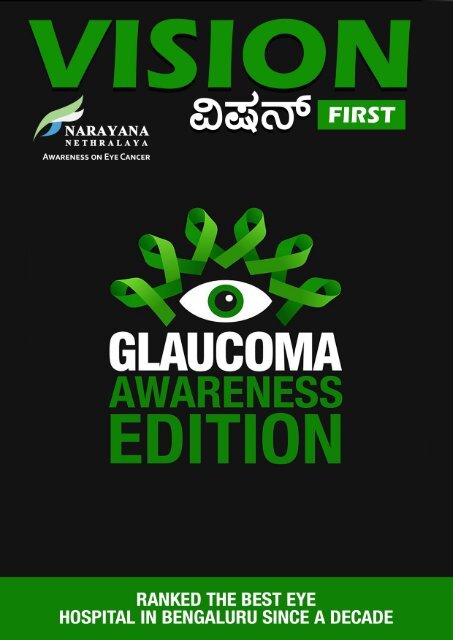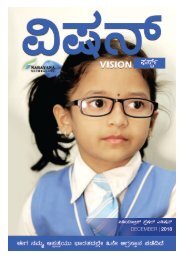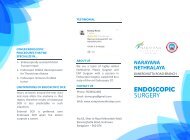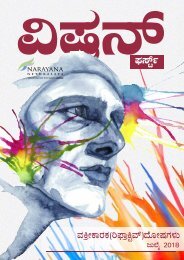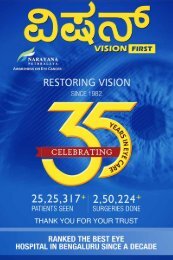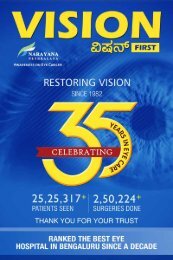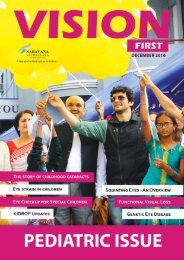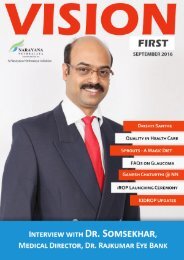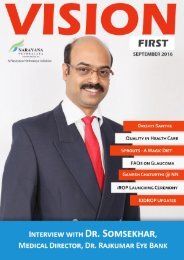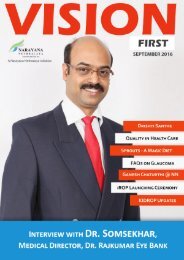Glaucoma English Edition high res
Create successful ePaper yourself
Turn your PDF publications into a flip-book with our unique Google optimized e-Paper software.
Ranked once Again the<br />
BEST EYE HOSPITAL<br />
in Karnataka<br />
(Times Health survey 2016)<br />
CONTENTS<br />
Proudly P<strong>res</strong>ents<br />
08 14<br />
VISION<br />
FIRST<br />
Women and Eye Health<br />
<strong>Glaucoma</strong> and Exercise<br />
A FULL-FLEDGED ONLINE EYE CARE MAGAZINE FOR THE<br />
FIRST TIME IN INDIA<br />
Vision First is a Narayana Nethralaya initiative to bring to you the latest in eye health and <strong>res</strong>earch, in an<br />
informative and informal way. Our aim is to spread awareness on how to maintain the health of your eyes and<br />
give you the knowledge to care for diseases which can affect your vision. This online magazine will cover various<br />
aspects of common eye conditions and keep you abreast of all the scientific and technological advancement<br />
in the field of ophthalmology.<br />
It also endeavors to be a platform to bring together a community of Narayana Nethralaya patients to share their<br />
ideas and experiences and contribute to the society to empower and encourage the visually impaired.<br />
Happy Reading<br />
DIALY NEWS<br />
www.narayananethralaya.org<br />
/NNethralaya<br />
@NNethralaya<br />
STRAIGHT TO YOUR DESK<br />
narayananethralaya.org/online-magazine<br />
STRAIGHT TO YOUR PHONE<br />
SCAN to see<br />
the latest hospital and<br />
healthcare news<br />
01<br />
Impact of <strong>Glaucoma</strong> on<br />
driving<br />
20<br />
Life with glaucoma<br />
made easier<br />
Who is at risk for<br />
retinal detachment?<br />
<strong>Glaucoma</strong> medications<br />
10<br />
18<br />
Published quarterly, The Narayana<br />
Nethralaya Vision first is an independent<br />
voice for the hospital, health and agedcare<br />
professional, containing regular<br />
featu<strong>res</strong> on major projects, health care<br />
disciplines, eHealth, news, conferences<br />
and events.<br />
07 29<br />
How will I know if I have diabetic<br />
retinopathy?<br />
Accomadation for outstation<br />
patients<br />
2 Narayana Nethralaya | Ranked Among The Top 10 Eye Hospitals in India Since A Decade www.narayananethralaya.org<br />
Narayana Nethralaya | Ranked Among The Top 10 Eye Hospitals in India Since A Decade www.narayananethralaya.org 3
#2565<br />
Impact of <strong>Glaucoma</strong><br />
on Driving<br />
Dr Monika Soni<br />
Driving gives us independence and a sense of control over our lives. Being able to drive means one is not dependent<br />
on family members, friends or society. However, an unsafe driver poses a huge risk to himself and to others. A<br />
glaucoma patient with poor vision contributes to potential hazards on the road, and this becomes an important issue.<br />
FROM THE CHAIRMAN’S DESK<br />
<strong>Glaucoma</strong> is one of the leading causes of irreversible blindness in our country. As it has no symptoms in the early<br />
stages and can go unnoticed, people may realize that they are suffering from glaucoma only after the disease has<br />
reached an advanced stage. Though it’s not curable, if detected early, the prog<strong>res</strong>sion of the glaucoma can be halted<br />
and total blindness can be prevented.<br />
Since patients who better understand their disease and its treatment have better success in managing their medical<br />
condition, we believe that patient education is an important part of long-term outcomes for glaucoma patients. This<br />
issue of Vision First provides a detailed explanation of glaucoma, its consequences, and the nature and importance of<br />
treatment, so that glaucoma patients and their family members have a better knowledge of the disease and how to<br />
manage it.<br />
At the start of the new academic year, we would like to reiterate the importance of good vision for the educational,<br />
physical and social development of children. Given a choice, many kids would prefer to spend all day indoors, glued to<br />
their digital screens. F<strong>res</strong>h air, sunshine, and exercise benefit not only the body, but also the mind. Children who spend<br />
time playing outdoors can prevent myopia (short-sightedness) from developing and prog<strong>res</strong>sing, get better sleep, get<br />
relief from st<strong>res</strong>s and anxiety, prevent childhood obesity, improve their imagination and develop good social skills.<br />
Encourage your children to eat healthy and spend more time outdoors this summer.<br />
Best Regards,<br />
Dr. K. Bhujang Shetty,<br />
Chairman and Managing Director,<br />
Narayana Nethralaya Hospital Bangalore<br />
What is the impact that<br />
glaucoma has on driving?<br />
To understand this we need to understand the effects that glaucoma has on a patient’s vision.<br />
Patients suffering from glaucoma can have loss of vision that ranges from mild to very severe.<br />
Loss of vision in glaucoma usually starts from the periphery or the sides. As the disease prog<strong>res</strong>ses the loss of vision<br />
prog<strong>res</strong>ses from the periphery towards the center.<br />
Peripheral loss of vision that patients with glaucoma suffer from makes it difficult for them to see objects that lie in their<br />
outer field of vision, such as pedestrians and vehicles coming in from the sides.<br />
For anyone who is driving, peripheral vision or its loss becomes a major concern since a person in the driver’s seat<br />
needs to be well aware of his environment. For this, good peripheral vision is a must, especially for the safe changing<br />
of lanes. Along with compromised vision, if a person has reduced cognitive ability and slower reflexes, driving becomes<br />
even more dangerous. A visual field test, which is a diagnostic test done routinely for glaucoma patients, can help<br />
assess the extent of a patient’s horizontal visual field loss.<br />
To be eligible for a driving license, most foreign countries have driving standards, which include certain criteria for vision<br />
that a person applying for a driver’s license should fulfill. The United Kingdom follows 2 standards (UK guidelines 2013)<br />
which include one for visual acuity and the other for field of vision.<br />
Unfortunately, in India, people applying for a driving license are not made to undergo a field of vision test and many a<br />
time, people with defective vision are not aware that they have compromised vision. This further increases the risk of<br />
accidents on the road.<br />
Drivers with perfect vision can also have accidents. If you find yourself in a situation where you have had an accident<br />
which you know is your fault or if you find yourself having near misses then you should re-evaluate your ability to drive.<br />
4 Narayana Nethralaya | Ranked Among The Top 10 Eye Hospitals in India Since A Decade www.narayananethralaya.org<br />
Narayana Nethralaya | Ranked Among The Top 10 Eye Hospitals in India Since A Decade www.narayananethralaya.org 5
So, what should you do if you have glaucoma and are concerned that you might not be driving safely? Ask a family<br />
member to accompany you on a drive and evaluate the situation. Discuss any concerns that you may have with your<br />
doctor.<br />
Be open to suggestions that friends and family and your health care providers give you. It might mean a compromise on<br />
your freedom and independent commute, but safety should always come first. We must remember that we share the<br />
roads with others, so our own safety and the safety of others should be of prime concern to us always.<br />
Constriction of the field of vision in a glaucoma patient<br />
Blurred vision in a patient with glaucoma<br />
Glare that a patient with<br />
glaucoma might experience<br />
6 Narayana Nethralaya | Ranked Among The Top 10 Eye Hospitals in India Since A Decade www.narayananethralaya.org<br />
Narayana Nethralaya | Ranked Among The Top 10 Eye Hospitals in India Since A Decade www.narayananethralaya.org 7
5. Lifestyle choices - Eye health is affected by poor lifestyle choices<br />
such as smoking, drinking alcohol, lack of proper nutrition and physical<br />
activity, which can lead to medical conditions such as diabetes, strokes<br />
and <strong>high</strong> blood p<strong>res</strong>sure. Obesity due to lack of exercise and poor diets<br />
are on the rise among the adult female population. More women are also<br />
smoking and drinking as compared to earlier.<br />
6. Socio-economic factors - Vision loss can be prevented with early<br />
detection and treatment of eye problems. In many parts of the world,<br />
women are still unable to access quality eye health care due to various<br />
social or economic factors. Women have to juggle the demands of a<br />
job, children, households and aging parents, and tend to neglect their<br />
own health.<br />
Women<br />
and Eye Health<br />
When was the last time<br />
you had an eye exam?<br />
The risks to eye health in women can be prevented with regular eye<br />
exams, avoiding smoking, wearing sunglasses when outdoors, and by<br />
following a healthy diet and exercise regimen. Your sight is precious and<br />
the power to prevent vision loss is in your hands.<br />
April is women’s eye health and safety<br />
month. Research shows that more<br />
women than men suffer from visual<br />
impairments. Therefore, it’s very important<br />
for women to take better care of their eyes.<br />
Here are some reasons<br />
why women could be more prone<br />
to eye problems than men:<br />
1. Longer lifespan - Statistics show that women usually have a longer lifespan than men. Many eye diseases such as<br />
cataract, glaucoma, AMD and diabetic retinopathy are related to advancing age.<br />
2. Hormonal fluctuations - Women experience serious ups and downs in hormone levels during puberty, menstruation,<br />
pregnancy and menopause. Hormonal changes have been linked to dry eye and other vision problems such as blurred<br />
vision, trouble focusing, and watery eyes.<br />
3. Autoimmune diseases - Women are more susceptible to develop autoimmune diseases such as Sjögren’s Syndrome,<br />
Lupus, Multiple Sclerosis, Rheumatoid arthritis, Hyperthyroidism and Scleroderma. Vision can be greatly impacted by<br />
these conditions.<br />
4. Medications - Compared to men, women generally take more p<strong>res</strong>cription and non-p<strong>res</strong>cription drugs such as birth<br />
control pills and medication for hormone replacement. Many of these drugs can have serious side effects which can<br />
affect vision.<br />
8 Narayana Nethralaya | Ranked Among The Top 10 Eye Hospitals in India Since A Decade www.narayananethralaya.org<br />
Narayana Nethralaya | Ranked Among The Top 10 Eye Hospitals in India Since A Decade www.narayananethralaya.org 9
Who is at risk for<br />
retinal detachment?<br />
The Four Stages Of<br />
Diabetic Retinopathy<br />
Though it is more common in people<br />
over age 40 and affects men more<br />
than women, retinal detachment can<br />
occur at any age to anyone.<br />
Risk factors for retinal detachment<br />
include severe myopia, retinal tears,<br />
a serious eye or head injury, family<br />
history, previous retinal detachment<br />
in the other eye, complications from<br />
an ocular surgery (especially cataract<br />
surgery), as well as eye conditions such<br />
as uveitis, retinoschisis, degenerative<br />
myopia, or lattice degeneration<br />
(peripheral retinal thinning).<br />
How is<br />
AMD detected?<br />
When AMD is in its early stages, it can be detected<br />
during a comprehensive eye examination, generally<br />
before any of the symptoms are noticed by the patient.<br />
Changes in vision such as distortion or blurring should<br />
be reported to an eye doctor who can detect AMD with a<br />
dilated eye exam. The earlier the disease is detected, the<br />
more <strong>res</strong>ponsive it is to treatment.<br />
If AMD is suspected, it can be diagnosed with the<br />
following tests:<br />
Visual acuity test - A standardized eye chart (Snellen<br />
chart) is used to determine how well you see at distances.<br />
Dilated eye exam - Eye drops are used to widen or dilate<br />
the pupils to provide a better view of the back of your eye.<br />
The ophthalmologist will then use a special magnifying<br />
lens to check for any abnormalities in your retina and<br />
macula.<br />
Amsler grid - is a special grid that’s made up of horizontal<br />
and vertical lines and a dot in the centre. Changes in your<br />
central vision may cause the lines in the grid to disappear,<br />
appear wavy, look faded or distorted, which is a sign of<br />
AMD. This test will give your ophthalmologist a better idea<br />
of how damaged your macula is. Since damage to the<br />
macula affects central vision, usually the lines towards<br />
the centre of the grid appear broken or distorted.<br />
Retinal Imaging - In order to determine the damage caused<br />
by macular degeneration, detailed images of your retina<br />
are used as part of the examination, using the following<br />
methods:<br />
Fluo<strong>res</strong>cein angiogram - In this test, a fluo<strong>res</strong>cent dye is<br />
injected into a vein in your arm. As the dye passes through<br />
the blood vessels in your eye, detailed images are taken<br />
with a special camera. These images can point out leaking<br />
blood vessels or abnormal new blood vessels that may be<br />
growing under the retina. This procedure can identify the<br />
type of AMD you have.<br />
Optical coherence tomography (OCT) - Similar to an<br />
ultrasound test, which uses sound waves to capture<br />
images of living tissues, OCT uses light waves to take<br />
<strong>high</strong>-<strong>res</strong>olution images of the retina and macula. This<br />
enables the ophthalmologist to establish whether any<br />
fluid has leaked through into the retina, or whether the<br />
macula is abnormal or thickened.<br />
Fundus Photography - the inside of your eye is<br />
photographed with a special camera (a fundus camera),<br />
through which 3D images of your macula are captured.<br />
The ophthalmologist, with the help of these images can<br />
establish whether any damage has occurred to your<br />
retina.<br />
Mild nonproliferative retinopathy-<br />
At the early stage of this disease<br />
microaneurysms( small areas of<br />
balloon-like swelling in the retina’s<br />
tiny blood vessels) occur<br />
Moderate Nonproliferative Retinopathy-<br />
During this stage, some blood vessels that<br />
nourish the retina are blocked.<br />
1 2<br />
How can I<br />
While some factors like age, family history<br />
and genetics is not in your control,<br />
you can reduce your risk of AMD or slow its<br />
prog<strong>res</strong>sion by taking preventative measu<strong>res</strong><br />
such as avoiding smoking, exercising<br />
regularly to maintain a healthy weight,<br />
keeping your blood p<strong>res</strong>sure and cholesterol<br />
levels in check, and eating a diet rich in green,<br />
leafy vegetables, whole grains, yellow and<br />
orange fruit, and fish.<br />
prevent AMD?<br />
4<br />
Proliferative Retinopathy-<br />
At this advanced stage, new blood<br />
vessels grow, but they are abnormal<br />
and have thin, fragile walls. If they leak<br />
blood, it could lead to vision loss.<br />
3<br />
Severe Nonproliferative Retinopathy -<br />
In the third stage, more blood vessels are<br />
blocked, depriving several areas of the retina<br />
with blood supply. These areas of the retina<br />
send signals to the body to grow new blood<br />
vessels for nourishment.<br />
10 Narayana Nethralaya | Ranked Among The Top 10 Eye Hospitals in India Since A Decade www.narayananethralaya.org<br />
Narayana Nethralaya | Ranked Among The Top 10 Eye Hospitals in India Since A Decade www.narayananethralaya.org 11
12 Narayana Nethralaya | Ranked Among The Top 10 Eye Hospitals in India Since A Decade www.narayananethralaya.org<br />
Narayana Nethralaya | Ranked Among The Top 10 Eye Hospitals in India Since A Decade www.narayananethralaya.org 13
<strong>Glaucoma</strong> and<br />
Exercise Dr Monika Soni<br />
Today yoga has a global p<strong>res</strong>ence and a lot of people worldwide<br />
are doing yoga as part of their fitness regimen. Some asanas<br />
in yoga are not advisable for glaucoma patients and it is<br />
important for those suffering from glaucoma to be aware<br />
of these asanas. Sheershasana is a yoga position in which<br />
the patient stands upside down or on his head. This asana is<br />
known to cause a temporary increase in the eye p<strong>res</strong>sure and<br />
should be avoided in patients who have glaucoma.<br />
Some types of glaucoma such as the closed angle type are<br />
not <strong>res</strong>ponsive to the effects of exercise and others such as<br />
pigmentary glaucoma may develop a temporary increase in<br />
IOP after vigorous exercise. Hence patients with glaucoma<br />
should always check with their doctor about which exercises<br />
are suitable for them.<br />
<strong>Glaucoma</strong> patients should follow a few instructions while<br />
exercising which can reduce the rise of eye p<strong>res</strong>sure during<br />
exercise : One is to exhale during periods of maximum exertion<br />
such as when lifting weights and to inhale when lowering the<br />
weight. This will help avoid the Valsalva effect (which is when<br />
a person exhales forcefully with a closed mouth or held nose<br />
and the exit of air is blocked).<br />
The Valsalva effect can increase eye p<strong>res</strong>sure dramatically,<br />
sometimes up to 300% of the normal p<strong>res</strong>sure.<br />
While doing yoga, avoid all inverted positions including<br />
headstands and inversions since all inverted positions raise<br />
IOP substantially.<br />
<strong>Glaucoma</strong> is a condition which affects the optic nerve in the eye and this is usually due to an increase in the eye<br />
p<strong>res</strong>sure. Some patients can be affected by glaucoma and develop weakness of the optic nerve even though their<br />
eye p<strong>res</strong>sure is normal. This generally occurs due to poor blood flow to the eye. Blood flow to the eye can decrease<br />
due to low blood p<strong>res</strong>sure and poor circulation.<br />
While intraocular p<strong>res</strong>sure (IOP) in glaucoma patients can be lowered with medication, laser treatment or surgery,<br />
there is some evidence that a regular moderate intensity exercise can help in decreasing the eye p<strong>res</strong>sure. Most<br />
exercise or activity can improve blood circulation to the optic nerve and protect it from damage to some extent.<br />
So which exercises are good for glaucoma patients and which are bad?<br />
The long term effect of exercise on glaucoma<br />
prog<strong>res</strong>sion is not clearly known, but anything<br />
that improves overall health and helps in<br />
maintaining the integrity of the optic nerve is<br />
a positive benefit.<br />
Aerobic exercises, running, swimming and<br />
jogging are cardiovascular exercises which<br />
help increase blood flow to the heart and also<br />
to the optic nerve and are good for the eye.<br />
However, if you are a glaucoma patient and<br />
have recently undergone an eye surgery, you<br />
should avoid swimming for a few weeks after<br />
the surgery or until your doctor gives you the<br />
go ahead.<br />
Certain exercises like squat thrusts and lifting<br />
very heavy weights can cause the eye p<strong>res</strong>sure to rise for a short<br />
while during the exercise. It is not just the lifting of weights but<br />
also holding one’s breath as one exercises that can be bad.<br />
Patients with glaucoma can continue to exercise and even lift<br />
weights which are not too heavy but should avoid holding their<br />
breath while doing it.<br />
Exercise,<br />
Running and Yoga<br />
Sheershasana or<br />
Lifting heavy weights<br />
can increase the eye<br />
p<strong>res</strong>sure briefly<br />
14 Narayana Nethralaya | Ranked Among The Top 10 Eye Hospitals in India Since A Decade www.narayananethralaya.org<br />
Narayana Nethralaya | Ranked Among The Top 10 Eye Hospitals in India Since A Decade www.narayananethralaya.org 15
Diet<br />
Various studies have been undertaken to study the role of diet in glaucoma. A diet rich in green leafy vegetables is<br />
supposed to lower the eye p<strong>res</strong>sure. Dietary nitrates in green leafy vegetables lowers risk of developing open angle<br />
glaucoma.<br />
Lifestyle<br />
changes that help<br />
lower IOP- Dr Bhavin Tilva<br />
In today’s world, people are quite aware about how lifestyle choices affect our overall health, and the same goes for<br />
glaucoma. Until now it was believed that lifestyle changes don’t play a role in glaucoma, but recent studies have shown<br />
the role of lifestyle factors which influence eye p<strong>res</strong>sure - the major modifiable risk factor for glaucoma.<br />
DHA (docosahexanoeic acid) is an omega- 3 fatty acid and is helpful in p<strong>res</strong>erving a healthy retina and lowering the IOP.<br />
Rich sources of DHA such as salmon, shellfish and tuna should be consumed twice or thrice a week. If natural addition<br />
to the diet is not possible, DHA supplements in the form of fish oil supplements can be taken.<br />
A diet rich in lutein and zeaxanthin helps in lowering intraocular p<strong>res</strong>sure. It avoids oxidative damage to the optic nerve.<br />
Spinach, broccoli and sprouts are rich sources of lutein and zeaxanthin.<br />
Antioxidants provide nutrients and strengthen the muscles and nerves in the eye. Rich sources of antioxidants are<br />
blueberries, grapeseed extract, goji berries, pecan nuts and cranberries.<br />
Foods which are rich in trans-fats, the kind found in deep fried food, prevent the optimal functioning of omega 3- fatty<br />
acids and increases eye p<strong>res</strong>sure. Such food should be avoided.<br />
Musical instruments<br />
such as the trumpet and the saxophone are known to cause an increase in the eye p<strong>res</strong>sure. <strong>Glaucoma</strong> patients are<br />
advised to avoid playing such <strong>high</strong> <strong>res</strong>istance wind instruments which can increase the intraocular p<strong>res</strong>sure.<br />
Lifestyle choices can, to some extent, influence eye p<strong>res</strong>sure and affect the risk of developing glaucoma, but there aren’t<br />
enough proven studies about the same in glaucoma patients. However, a shift towards a healthier lifestyle makes for<br />
an overall positive change.<br />
Sources rich in antioxidants<br />
However, it is not mandatory that factors which increase intraocular p<strong>res</strong>sure (IOP) may cause glaucoma, and those that<br />
lower IOP may prevent the development of glaucoma. There are various factors which contribute to the development of<br />
glaucoma and modifications in one’s lifestyle are just supplementary to these.<br />
This means that certain lifestyle factors that increase the intraocular p<strong>res</strong>sure need not actually increase the risk of<br />
glaucoma and similarly certain factors which could reduce the intraocular p<strong>res</strong>sure need not actually decrease one’s<br />
risk of glaucoma.<br />
Exercise<br />
Activities which raise your pulse by 20 to 25, like walking<br />
briskly, can help reduce IOP. The more number of steps<br />
a person walks throughout the day, less likelihood of an<br />
increase in IOP. Aerobics is known to cause a temporary<br />
decrease in the intraocular p<strong>res</strong>sure but it has not<br />
been tested in glaucoma patients. Swimming reduces<br />
vulnerability of the optic nerve to an increase in the<br />
intraocular p<strong>res</strong>sure.<br />
Lifting of heavy weights is known to cause a temporary<br />
increase in the intraocular p<strong>res</strong>sure. Hence, patients who<br />
already suffer from glaucoma are advised to avoid lifting<br />
very heavy weights.<br />
Habit forming substances<br />
such as caffeine, alcohol, tobacco and marijuana are<br />
known to have a negative effect on eye p<strong>res</strong>sure.<br />
Caffeine, which is consumed widely, is known to cause a<br />
temporary increase in the eye p<strong>res</strong>sure.<br />
Consumption of caffeine in small quantities is alright,<br />
but an excessive intake of caffeine is has been proven to<br />
increase the risk of glaucoma.<br />
Alcohol is known to decrease the eye p<strong>res</strong>sure for a short<br />
duration but a daily consumption of alcohol is supposed<br />
to increase the risk of glaucoma.<br />
Yoga, which is a very popular form of exercise includes<br />
various ‘asanas’ or positions. Some of these asanas,<br />
particularly those with the head – down position<br />
(sheershasana) have been proven to cause an increase in<br />
the eye p<strong>res</strong>sure. Therefore, patients with glaucoma are<br />
advised to avoid such positions.<br />
Smoking cigarettes is known to increase the risk of<br />
glaucoma.<br />
Though marijuana is known to lower eye p<strong>res</strong>sure, it is not<br />
recommended for treatment due to its side effects.<br />
16 Narayana Nethralaya | Ranked Among The Top 10 Eye Hospitals in India Since A Decade www.narayananethralaya.org<br />
Narayana Nethralaya | Ranked Among The Top 10 Eye Hospitals in India Since A Decade www.narayananethralaya.org 17
Q: My doctor has p<strong>res</strong>cribed more than one eye drop for glaucoma. Can I put them into the eye one<br />
after the other?<br />
A: No, usually you should keep a gap of 5-10 minutes between two eye drops as it helps in better absorption of the drop<br />
and helps in better eye p<strong>res</strong>sure control.<br />
Q: Is it safe to put in an extra drop just to make sure?<br />
A: Yes, if you are not certain that the first drop went in, it is safe to put in another drop. In general, it is best to avoid<br />
putting in more than one drop.<br />
<strong>Glaucoma</strong><br />
medications<br />
Know your medications and manage<br />
your glaucoma better<br />
<strong>Glaucoma</strong> is a disease in which the p<strong>res</strong>sure inside<br />
the eye increases, and causes damage to the<br />
nerve of the eye, leading to irreversible loss of vision.<br />
Usually, it has no symptoms in the early stages and<br />
can go unnoticed, only to be diagnosed later with<br />
severe vision loss. It is not surprising that glaucoma<br />
has been called ‘The silent thief of sight’!<br />
How glaucoma affects vision<br />
There is a small space within the eye called the<br />
anterior chamber. Clear liquid (called the aqueous<br />
humor) flows in and out of the anterior chamber. It<br />
is the aqueous humor that plays an integral part in<br />
maintaining the p<strong>res</strong>sure in the eyes. In some people,<br />
due to various reasons, the p<strong>res</strong>sure inside the eye<br />
rises. This increased eye p<strong>res</strong>sure, if left untreated<br />
can damage the eye nerve and can cause permanent<br />
vision loss. The disease usually affects both eyes,<br />
though one may be more severely affected than the<br />
other. Unfortunately, the damage to the eye nerve<br />
due to glaucoma is irreversible and the loss of vision<br />
cannot be reversed. But, this condition can be halted<br />
and the remaining vision can be retained if glaucoma<br />
gets diagnosed on time and appropriate treatment is<br />
started.<br />
A better understanding of your treatment and<br />
medications can make it easier to live with glaucoma<br />
Dr Shivani Dixit<br />
and easier for your doctor to control your disease. Here are<br />
answers to frequently asked questions by glaucoma patients<br />
regarding medications that are to be used:<br />
Q: How do my glaucoma eye drops work and help save<br />
my vision?<br />
A: The goal of glaucoma treatment is to lower the p<strong>res</strong>sure in<br />
your eye. It often starts with p<strong>res</strong>cription of eye drops. These<br />
can help decrease your eye p<strong>res</strong>sure by improving how fluid<br />
drains out of your eye or by decreasing the amount of fluid your<br />
eye produces.<br />
Q:What are the different types of medications available<br />
and do they have any side effects?<br />
A: There are different types of medications available for<br />
glaucoma. They do have a few side effects so; feel free to ask<br />
your doctor when he is starting you on treatment.<br />
Q: What precautions should I take while putting my<br />
eye drops?<br />
A: Wash your hands before instilling your drops. While opening<br />
the cap of your eye drop, be careful not to touch the nozzle of<br />
the bottle. Gently pull your lower eyelid and put one drop into the<br />
eye. Gently close your eye for a few seconds. Do not squeeze<br />
the eye forcefully after putting the drop, as it may cause the<br />
medication to come out of your eye and get wasted.<br />
Q: I miss instilling my eye drops often. Will it<br />
affect my vision?<br />
A: Missing your eye drops often leads to inadequate<br />
control of eye p<strong>res</strong>sure. In order for them to help your<br />
eyes, you will need to use your drops every day. Make it a<br />
part of your daily routine, like brushing your teeth. Follow<br />
your doctor’s instructions properly.<br />
Q: How important is it to put the drops at exactly<br />
the time stated?<br />
A: It is important to get into a routine and to instil the eye<br />
drops at around the same time each day, but the exact<br />
time is less important.<br />
There are several ways to help yourself remember when<br />
to put your drops in:<br />
• A chart with tick boxes,<br />
• A box with compartments for the drop bottles,<br />
• A special timer can be set to ring several times<br />
each day as required<br />
Q: Where should I keep the drops and for how<br />
long?<br />
A: Read the storage instructions mentioned on the cover<br />
of your eye drops. Keep your drops in a cool place or in the<br />
door of the refrigerator. Do not place them in the freezer<br />
section. Check the expiry date on unopened bottles before<br />
using them.<br />
Q: What happens if I forget to take my drops when<br />
I go out?<br />
A: Do not worry unduly if you forget on the odd occasion,<br />
but try to get into the habit of taking your drops with you<br />
wherever you go. If you have forgotten a drop, just put it<br />
as soon as possible after the time it was due.<br />
Q: Can I take other medicines at the same time as<br />
my glaucoma treatment?<br />
A: Patients with angle closure or narrow angle types of<br />
glaucoma should seek advice before taking some types of<br />
tranquillizer or certain asthma and indigestion medicines.<br />
However, glaucoma eye drops are usually safe if you<br />
have had laser treatment (laser iridotomy) or glaucoma<br />
surgery.<br />
Steroid (cortisone-type) drops and tablets should be used<br />
with caution because they can increase the p<strong>res</strong>sure in<br />
the eye.<br />
Always mention that you are on glaucoma medication<br />
when you visit a doctor for any other treatment.<br />
Q: Why do I have to see the eye specialist or<br />
attend the glaucoma clinic regularly?<br />
A: Even if your glaucoma is stable, it is important to<br />
attend the glaucoma clinic regularly. The purpose of your<br />
visits is to monitor your glaucoma (through optic nerve<br />
appearance, visual field and eye p<strong>res</strong>sure tests) and to<br />
ensure that the treatment is working.<br />
Q: Do I need to put the drops in before I come to<br />
the clinic?<br />
A: Yes, always continue as usual unless requested<br />
otherwise. It helps the doctor to judge the effect of the<br />
treatment.<br />
Timely instillation of glaucoma medications is<br />
of utmost importance<br />
The medical treatment of glaucoma is usually<br />
in the form of eye drops<br />
18 Narayana Nethralaya | Ranked Among The Top 10 Eye Hospitals in India Since A Decade www.narayananethralaya.org<br />
Narayana Nethralaya | Ranked Among The Top 10 Eye Hospitals in India Since A Decade www.narayananethralaya.org 19
Life with glaucoma<br />
made easier<br />
Here are some TIPS<br />
to make the life of a<br />
glaucoma patient easier<br />
<strong>Glaucoma</strong> is one of the leading causes of irreversible<br />
blindness in our country. It has been aptly called the<br />
“silent thief of sight”. As it is a symptomless disease,<br />
people usually do not realize that they are suffering from<br />
glaucoma unless they visit the ophthalmologist or have<br />
reached an advanced stage of disease.<br />
<strong>Glaucoma</strong> affects the quality of life of millions of people.<br />
In the early stage of glaucoma, patients experience<br />
compromised vision which affects their quality of life. This<br />
worsens as the disease prog<strong>res</strong>ses. Ocular discomfort,<br />
psychological factors, economic factors and social<br />
constraints contribute to the burden of the disease.<br />
<strong>Glaucoma</strong> is not curable but if detected early, the<br />
prog<strong>res</strong>sion of the disease can be halted and total<br />
blindness can be prevented.<br />
Here is an example to explain the difficulties a patient<br />
diagnosed with glaucoma faces:<br />
Dr Shruthi S<br />
A 46 year old auto driver visited an ophthalmologist with<br />
complaints of difficulty in near vision. He was examined<br />
in detail and was diagnosed to have an advanced stage of<br />
glaucoma where he had significant loss of the peripheral<br />
field of vision.<br />
He was started on multiple eye drops in both eyes. He was<br />
advised to use these medications and was also advised<br />
not to drive as his vision was severely compromised.<br />
On asking him for a detailed family history, he said his<br />
father had an eye disease for which he had consulted a<br />
doctor and was asked to get some investigations done.<br />
Unfortunately, before he could take him to the hospital, his<br />
father fell sick and passed away. It is possible that he had<br />
an unnoticed family history of glaucoma.<br />
Before the disease is detected:<br />
Prevention is better than cure<br />
Ophthalmic consultation is a must for everyone over the age of 40, in an eye hospital rather than getting tested for<br />
near vision at an optical shop.<br />
<br />
Get glaucoma screening done if you have family history of glaucoma, diabetes, hypertension, heart disease, asthma,<br />
arthritis, migraine, thyroid disease, using minus or plus powered glasses, any history of trauma to eye. If detected in the<br />
early stage, the disease can be ar<strong>res</strong>ted and existing vision can be retained.<br />
<br />
Babies born with whitish coloured eyes or bigger than normal eyes, or babies with severe watering and difficulty in<br />
opening their eyes at birth, should be screened for congenital glaucoma.<br />
After the disease is detected:<br />
Prevention is better than cure<br />
If you have undergone any surgery or laser treatment for glaucoma, it is important to understand that these procedu<strong>res</strong><br />
are performed to reduce the intra-ocular p<strong>res</strong>sure and are an attempt to <strong>res</strong>tore the remaining vision.<br />
Regular usage of medications –<br />
- keeping alarms on your mobile phones will remind you to put your medications on time<br />
- making a simple drug chart in a pocket diary as shown in the figure below so that it can be noted and showed to your<br />
doctor as well.<br />
The problems that the<br />
auto driver is facing are:<br />
Financial constraints for consultation fees and investigations, to buy medications, and for transportation - to make<br />
regular visits to his eye doctor.<br />
He has been an auto driver for 20 long years. It is challenging for him to change his profession as it is no longer safe<br />
for him to drive his auto.<br />
Adherence to medications becomes difficult as he tends to forget to use the medications on time. Missing his<br />
medication is harmful for him since it can worsen his glaucoma and make him more visually handicapped.<br />
Psychologically, he is st<strong>res</strong>sed as he is the bread winner in the family and has to support his entire family.<br />
This is just one example! There are many similar stories that have affected the lives of many people. So, what can a<br />
glaucoma patient do to make his life easier?<br />
Date Morning 8 am Afternoon 1pm Night 8pm<br />
RE LE RE LE RE LE<br />
RE LE RE LE RE LE<br />
RE LE RE LE RE LE<br />
Follow the instructions of your doctor and attend follow up examinations as advised<br />
Follow the technique properly while instilling the medication into the eye so that the desired effect of medication is<br />
attained.<br />
If you have any difficulty in instilling the medication or if you have any discomfort with the medication, let your doctor<br />
know about it rather than stopping medication on your own.<br />
Never stop the medications on your own - people usually think that there is no change in vision and stop the<br />
medication themselves. This can compromise your vision further.<br />
20 Narayana Nethralaya | Ranked Among The Top 10 Eye Hospitals in India Since A Decade www.narayananethralaya.org<br />
Narayana Nethralaya | Ranked Among The Top 10 Eye Hospitals in India Since A Decade www.narayananethralaya.org 21
Normal tension glaucoma /Low tension glaucoma:<br />
<strong>Glaucoma</strong><br />
risk factors<br />
Dr.Sruthi.P<br />
<strong>Glaucoma</strong> is a disease that damages the eye’s optic nerve. In glaucoma the fluid p<strong>res</strong>sure inside the eye increases,<br />
and this leads to prog<strong>res</strong>sive damage of the optic nerve, <strong>res</strong>ulting in a gradual loss of vision. The front half of the<br />
eye is filled with a fluid known as the “aqueous humor”.<br />
This fluid is continuously produced and constantly flows out of the eye, maintaining a steady p<strong>res</strong>sure inside the eye.<br />
If there is either reduced drainage or excessive production of this fluid, the p<strong>res</strong>sure in the eye will increase, leading to<br />
glaucoma. Not everyone with <strong>high</strong> eye p<strong>res</strong>sure will develop glaucoma, and some people with normal eye p<strong>res</strong>su<strong>res</strong><br />
may also develop glaucoma. There are several other factors which determine this.<br />
Primary open angle glaucoma<br />
Primary open angle glaucoma is the most common type of glaucoma. In this type of glaucoma, the part of the eye<br />
through which the fluid of the eye flows out is open, permitting the outflow of fluid, but the patient still has <strong>high</strong> p<strong>res</strong>sure.<br />
This type of glaucoma develops slowly without any symptoms. Initially it affects the peripheral or side vision and very<br />
gradually prog<strong>res</strong>ses to the centre. This is the reason why many people are not aware that they have the condition<br />
until they have significant vision loss affecting central vision. <strong>Glaucoma</strong> has been labelled as the “sneak thief of sight”<br />
because many people remain undiagnosed until irreversible loss of vision occurs. If left untreated it can even cause<br />
blindness.<br />
In this type of glaucoma the optic nerve can get affected even though the p<strong>res</strong>sure in the eye is normal. Although its<br />
cause is not entirely known or understood, normal tension glaucoma is believed to occur either because of an extremely<br />
fragile optic nerve that can get damaged even though the p<strong>res</strong>sure in the eye is normal, or because of reduced blood<br />
flow to the optic nerve. Because of its silent nature, people usually do not have any visual complaints until a very<br />
advanced stage of the disease.<br />
Risk factors for normal tension glaucoma are:<br />
• Family history of normal tension glaucoma<br />
• Race - Japanese ancestry<br />
• Thinner corneas<br />
• Heart disease<br />
• Migraine and peripheral vascular disease<br />
Secondary glaucoma:<br />
There are certain other types of glaucoma where there is an identifiable cause for increased eye p<strong>res</strong>sure <strong>res</strong>ulting in<br />
optic nerve damage and vision loss. These are called secondary glaucoma. It may be caused by prolonged, indiscriminate<br />
use of steroids, severe diabetic retinopathy, injuries to the eye, inflammation of the eye (uveitis) or advanced cases of<br />
cataract.<br />
If you believe you have any of these risk factors get an eye examination done. Always remember to inform your eye<br />
doctor about the risk factors that you have. This will help your doctor decide how often you need to get your eyes<br />
examined. <strong>Glaucoma</strong> is a disease that can be easily controlled if it is diagnosed early. So encourage your friends and<br />
family to get regular eye examinations done.<br />
Risk factors for primary open angle glaucoma are:<br />
• Age more than 40 years<br />
• Race –African Americans<br />
• Family history of glaucoma<br />
• Systemic diseases such as diabetes mellitus, hypertension, heart disease<br />
• Injuries to the eye<br />
• High myopia<br />
Angle closure glaucoma or closed angle glaucoma:<br />
It is a less common type of glaucoma which occurs due to narrow drainage channels in the eye. Gradual closing of the<br />
angle is called chronic angle closure and if the drainage angle closes suddenly, it causes an acute angle closure attack.<br />
Acute angle closure glaucoma usually p<strong>res</strong>ents as an emergency. A patient who is in an acute angle closure attack will<br />
have symptoms of eye pain, nausea, vomiting, redness and blurred vision due to a rapid increase in the eye p<strong>res</strong>sure. In<br />
such cases the patient needs immediate treatment by an eye specialist.<br />
Risk factors for angle closure glaucoma:<br />
• Age more than 40 years<br />
• Race - East Asians<br />
• Family history of glaucoma<br />
• Women<br />
• High hypermetropia or those with a <strong>high</strong> plus power<br />
22 Narayana Nethralaya | Ranked Among The Top 10 Eye Hospitals in India Since A Decade www.narayananethralaya.org<br />
Narayana Nethralaya | Ranked Among The Top 10 Eye Hospitals in India Since A Decade www.narayananethralaya.org 23
World<br />
<strong>Glaucoma</strong> Week<br />
Who is at <strong>high</strong> risk for glaucoma?<br />
If you are more than 60 years old, have blood relatives with glaucoma, are on treatment with steroids (in the form of<br />
tablets, skin ointments, inhalers, eye drops), have diabetes or <strong>high</strong> blood p<strong>res</strong>sure, are near sighted or have a history<br />
of trauma, your risk of developing glaucoma increases.<br />
What are<br />
floaters?<br />
Dr Rwithuja Thomas<br />
Part of the natural aging process, floaters are black or white spots in our vision. They can appear as specks,<br />
strings, or cobwebs that drift about when you move your eyes and appear to shift away when you try to look<br />
at them directly.<br />
With age, the jelly-like substance (vitreous) inside your eyes begins to dissolve and becomes more liquid.<br />
Microscopic fibers within the vitreous tend to aggregate and cast tiny shadows on the retina as light passes<br />
through the eye. These shadows are called floaters.<br />
Floaters can be distracting at first, but usually settle down at the bottom of the eye (below the line of sight),<br />
becoming less bothersome over time.<br />
What is Tonometry? Why is Gonioscopy important?<br />
Tonometry is a diagnostic test that<br />
measu<strong>res</strong> the fluid p<strong>res</strong>sure, known as<br />
intraocular p<strong>res</strong>sure (IOP), inside your<br />
eye.<br />
The tonometry test is important as it<br />
can help your doctor evaluate whether<br />
or not you may be at risk of glaucoma.<br />
<strong>Glaucoma</strong> is a serious eye disease that is<br />
characterised by increased fluid p<strong>res</strong>sure<br />
within the eye which can damage your<br />
optic nerve.<br />
<strong>Glaucoma</strong> Treatment by Laser<br />
Gonioscopy is a painless eye examination<br />
of the front portion of your eye (anterior<br />
chamber), to examine whether the<br />
area where fluid drains out of your eye<br />
(drainage angle) is open or closed.<br />
This test is important as it helps<br />
your doctor to diagnose and monitor<br />
various eye conditions associated with<br />
glaucoma.<br />
<strong>Glaucoma</strong> is a treatable disease that needs early detection as the<br />
damage is irreversible. Treatment can include eye drops, laser or<br />
surgery. Laser treatments such as Laser Peripheral Iridotomy and<br />
Selective Laser Trabeculoplasty are used to lower the intraocular<br />
p<strong>res</strong>sure and increase the outflow of fluid from the eye.<br />
What is a Visual Field test?<br />
The Visual Field test is a method<br />
of measuring your peripheral or<br />
side vision (which is affected first<br />
by glaucoma), through which<br />
your doctor can diagnose and<br />
monitor glaucoma. The data from<br />
the test is used to determine the<br />
severity of your glaucoma, level of<br />
vision loss, damage to the visual<br />
pathways of the brain, and other<br />
optic nerve diseases.<br />
Symptoms of eye floaters<br />
may include:<br />
• Small dark spots in the vision<br />
• Spots that move when you move your eyes<br />
• Spots that are more noticeable when you look at a white<br />
or light-colored background, such as a blue sky, a white wall<br />
or a computer screen with a background<br />
Causes of eye floaters include:<br />
• Age-related eye changes<br />
• Retinal detachment or tears<br />
• Inflammation in the back of the eye - due to the release<br />
of inflammatory material into the vitreous that are seen<br />
as floaters<br />
• Bleeding in the eye - Blood can be seen as floaters.<br />
Bleeding in the vitreous can be due to diabetes, hypertension<br />
and blocked vessels or injury<br />
• Eye surgeries and eye medications - Medications that<br />
are injected into the vitreous can cause floaters to develop<br />
till they are absorbed into the eye. Surgery of the<br />
retina involves adding silicone into the vitreous that can<br />
also be seen as floaters.<br />
Factors that can increase your<br />
risk of floaters include:<br />
• Age over 50<br />
• Nearsightedness<br />
• Eye trauma<br />
• Complications from cataract surgery<br />
• Diabetic retinopathy<br />
A sudden increase in the number of floaters or<br />
flashes of light can be symptoms of detachment of<br />
the retina, which is the nerve layer of the eye.<br />
Contact your ophthalmologist<br />
immediately if:<br />
• You see several floaters at once<br />
• See new floaters suddenly<br />
• Flashes of light along with the floaters<br />
• Darkness on any side of your visual field<br />
The above symptoms are painless but require urgent<br />
attention.<br />
24 Narayana Nethralaya | Ranked Among The Top 10 Eye Hospitals in India Since A Decade www.narayananethralaya.org<br />
Narayana Nethralaya | Ranked Among The Top 10 Eye Hospitals in India Since A Decade www.narayananethralaya.org 25
<strong>Glaucoma</strong> Statistics<br />
<strong>Glaucoma</strong> is one of the leading causes of<br />
irreversible blindness, where damage to the<br />
optic nerve leads to loss of visual function.<br />
Dr Guddeti Praveena<br />
Why is it important to know the statistics,<br />
percentages, proportions or the number of people<br />
affected with glaucoma?<br />
The prevalence is the proportion of a population with the disease<br />
at a given point of time. Hence, the answer to this question is<br />
that the awareness about its prevalence alerts individuals to<br />
the disease. This is necessary as early diagnosis, and therefore<br />
early intervention, is crucial in delaying the prog<strong>res</strong>sion of the<br />
disease process.<br />
What is Diabetic<br />
Retinopathy?<br />
Diabetic retinopathy is a serious complication of diabetes where tiny blood vessels inside the retina<br />
are damaged, causing them to bleed or leak fluid, leading to vision complications or even vision loss.<br />
How many people are affected by glaucoma?<br />
A recent systematic review estimated that the number of<br />
people aged between 40 - 80 years with glaucoma worldwide<br />
is 64.3 million, and that it will increase to 76 million in 2020 and<br />
111.8 million in 2040. The number of people blind and visually<br />
impaired due to glaucoma worldwide will be 2.1 million and 4.2<br />
million <strong>res</strong>pectively.<br />
How many people are affected by glaucoma in India?<br />
In India, the estimated number of cases of glaucoma is 12<br />
million. This is around one fifth of global burden of glaucoma.<br />
What are the different types of glaucoma and what is<br />
the prevalence of different types of glaucoma?<br />
There are different types of glaucomas like primary open angle<br />
glaucoma, angle closure glaucoma, congenital glaucoma and<br />
secondary glaucoma.<br />
> Prevalence of primary open angle glaucoma ranges from<br />
0.41 to 2.99%.<br />
> Prevalence of angle closure glaucoma is between 0.88 to<br />
7.24 %.<br />
> Prevalence of congenital glaucoma in South India is one in<br />
every 3300 children.<br />
> One of the risk factors for glaucoma known as the<br />
pseudoexfoliation is an abnormal material formed in the eye<br />
which can cause <strong>high</strong> p<strong>res</strong>su<strong>res</strong> in the eye. The prevalence of<br />
pseudoexfoliation glaucoma is reported to be between 1.87<br />
and 13.5%.<br />
> Studies have reported the prevalence of secondary<br />
glaucomas to be 0.08 to 0.3%.<br />
The <strong>high</strong>est rate of blindness in India is at least partially explained by the large proportion of the undiagnosed disease<br />
in the population based studies.So, get yourself screened for glaucoma and save your vision!<br />
26 Narayana Nethralaya | Ranked Among The Top 10 Eye Hospitals in India Since A Decade www.narayananethralaya.org<br />
Narayana Nethralaya | Ranked Among The Top 10 Eye Hospitals in India Since A Decade www.narayananethralaya.org 27
Challenging the<br />
challenges<br />
Narayana Nethralaya in collaboration with National Federation of the Blind and Sthree Vani - A WhatsApp group<br />
for visually impaired women, celebrated Women’s Day in a program exclusively for women with impairment.<br />
Ms. Rajani Gopal Krishna, the first visually impaired Chartered Accountant in India, was the chief guest who shared<br />
her journey and its challenges.<br />
Health is wealth –a workshop on Gynecology was conducted by Dr. Shilpa Venkatesh, a renowned Obstetrician<br />
and Gynecologist. The 1st Anniversary of Sthree Vani was celebrated and their services to the visually impairment<br />
community was narrated. Prizes were distributed by Mrs. Naina Shetty and Ms. Priya Seshadri to the winners of<br />
two fun filled competitions.<br />
Accommodation for<br />
outstation patients<br />
At Narayana Nethralaya, the comfort of our patients is very important to us. We understand that outstation patients<br />
who consult with us often have issues with proper accommodation while undergoing treatment.<br />
We are happy to announce that accommodation within the hospital premises is now available for outstation<br />
patients and their attender in a safe, clean and friendly environment. Services offered include AC rooms for Rs 2500<br />
and non-AC rooms for Rs 2000, with an attached bathroom.<br />
For room enqui<strong>res</strong>,<br />
please contact Mr. Naveen at 08066121311.<br />
Working hours 8 AM - 6 PM.<br />
28 Narayana Nethralaya | Ranked Among The Top 10 Eye Hospitals in India Since A Decade www.narayananethralaya.org<br />
Narayana Nethralaya | Ranked Among The Top 10 Eye Hospitals in India Since A Decade www.narayananethralaya.org 29
Ranked once Again the<br />
BEST EYE HOSPITAL<br />
in Karnataka<br />
(Times Health survey 2016)<br />
Thanks for Reading<br />
vision<br />
A Narayana Nethralaya Initiative<br />
FIRST<br />
We invite your feedback & suggestions.<br />
Would you like to contribute Articles or Testimonials?<br />
write us to wecare@narayananethralaya.com<br />
Editorial board : Mrs Shilpa Rudra, Mr Praveen.I.M, Mrs Chitra Seshadri<br />
Creatives & Photographs : Mr Najeeb Rahman, Mr Kallappa


